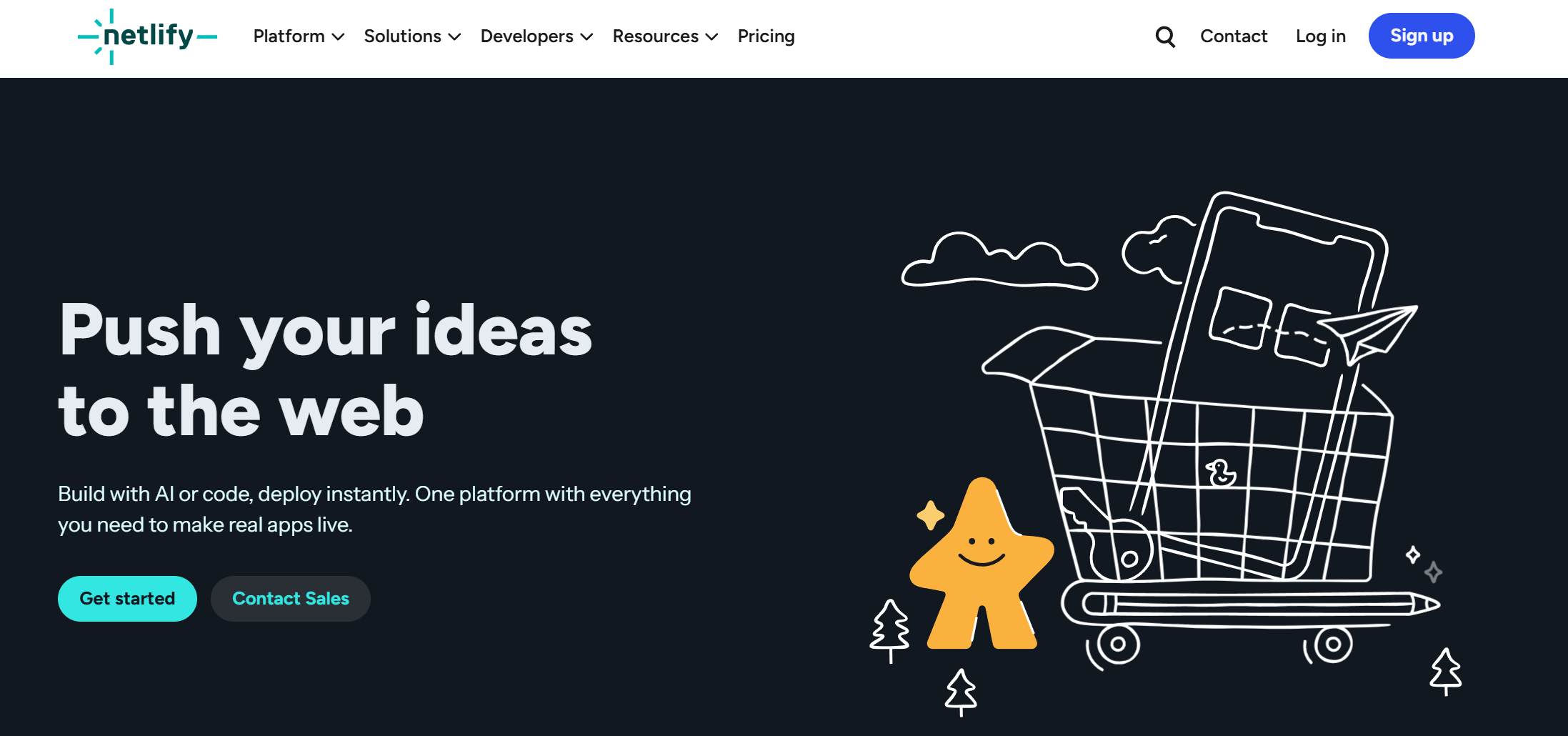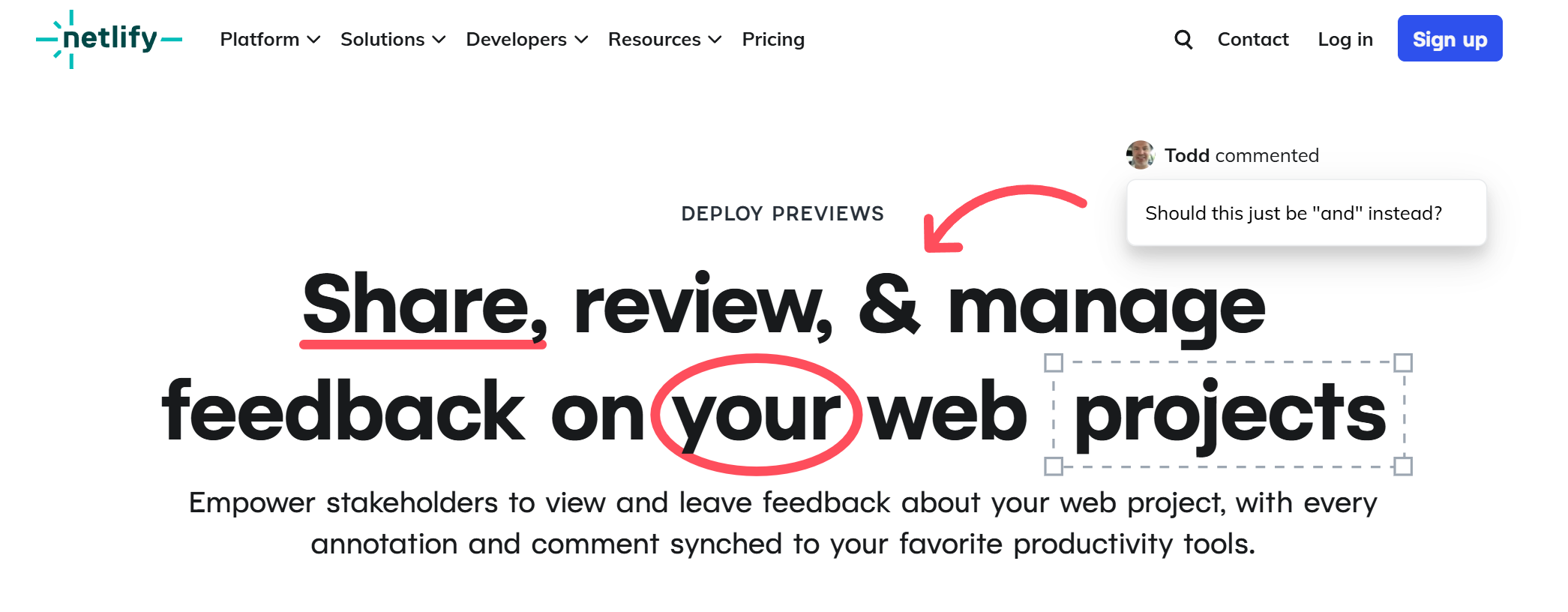Web hosting technologies are rapidly evolving and improving today, offering developers a wide range of opportunities and significant benefits. One of the most promising solutions in this area is Netlify, and we'll discuss it in our new article.
By reading our Netlify review for 2025, you'll gain useful information about this service's key features and operating modes. You'll also learn about its benefits, limitations, and current pricing plans.
Introduction to Netlify
So, let's start by answering the question: what is Netlify? It's a platform for developers that offers a set of tools and technologies for developing, deploying, and managing the backend processes of websites and web applications.
Netlify was launched in 2014, and as of 2025, it is used by more than 500,000 projects, including many well-known web applications and static sites of various types (blogs, eCommerce, etc.). The platform provides advanced web hosting infrastructure, process automation, and serverless capabilities — in-demand solutions for modern web development.
Netlify's operating principle differs significantly from traditional hosting. First, the developer integrates the platform with the GitHub repository to extract the website or application's source code. By supporting continuous delivery and continuous integration, Netlify helps developers accelerate and optimize web project deployment processes. In addition to GitHub, it easily integrates with other similar systems (GitLab, Bitbucket), and also allows you to run files from a local device or use project templates.
Netlify is considered one of the most popular JAMstack hosting services. This web development methodology enables the creation of fully functional websites and applications using three components: JavaScript, APIs, and markup languages (HTML, CSS). This architecture makes it possible to pre-compile the maximum allowable amount of HTML code and place it in a global content delivery network (CDN).

Source: Netlify
With JAMstack, developers don't need to run monolithic Netlify backend applications on the server side to generate dynamic content; instead, they can simply enable API integration. This significantly simplifies software development and improves the user experience.
Core Features and Tools
In this section, we'll explore key Netlify features that help developers launch web projects more easily, quickly, and efficiently.
Static Website Hosting
Integrating the service with a global content delivery network (CDN) significantly speeds up the deployment of web projects, helping to quickly deliver content to users from servers located in nearby locations.
Netlify technologies optimize the processing of user requests to websites by retrieving and processing HTML files directly from the server without interacting with the database. This reduces maintenance costs and improves the security of static web resources.
Continuous Deployment Based on Git Platforms
Native integrations with GitHub, GitLab, and Bitbucket enable Netlify's most important feature, continuous deployment. A developer simply pushes a commit to a connected Git repository to trigger the automated build and deployment of a website with the necessary plugins.
This option effectively automates not only the initial project deployment but also its updates whenever the codebase changes. This eliminates the need for developers to spend significant time on releases and project maintenance.
Serverless Functions
Using Netlify's serverless deployment platform, developers can implement backend service logic without having to manage servers. These functions can be written in JavaScript, TypeScript, or Go, ensuring high speed and responsiveness.
Netlify's native integrations with cloud providers help developers avoid wasting time deploying and managing server infrastructure. Instead, they can quickly and efficiently manage cloud resources, paying only for the amount consumed.
Deploy Previews
The platform automatically generates previews for each stage of website or application development in the form of a unique, permanent URL. The preview is posted as a commit status for easy collaboration. Deploy Previews lets you invite colleagues and stakeholders to evaluate, test, and provide feedback on the project.
Netlify Edge and Plugins
The Netlify Edge content delivery network optimizes web application performance through built-in features and third-party integrations. It allows developers to extend the software's standard capabilities with functionality for forms, split testing, analytics, authentication, and data protection.
Edge functions are launched from nearby CDN locations and run in a secure execution environment, guaranteeing maximum speed and performance. Netlify also has its own plugin ecosystem that can be easily integrated into applications without additional tools or API integrations.
Netlify Build
CI/CD infrastructure with Netlify Build provides a complete set of configurations and automations needed to productively deploy static sites and web applications.
Unlike traditional CI/CD solutions, it doesn't require full-time administration of machines or containers. Instead, developers can run frontend and backend code from a single repository, flexibly automating and customizing all stages of the process.
Agent Runner
Agent Runner is Netlify’s new solution for handling longer, more complex build tasks that can’t run on the standard CI/CD infrastructure. It lets developers execute builds or custom processes on their own machines or self-hosted agents while still integrating tightly with the Netlify workflow.
- Automate the work with leads from the Facebook advertising account
- Empower with integrations and instant transfer of leads
- Don't spend money on developers or integrators
- Save time by automating routine tasks
This is especially useful for large apps or legacy codebases that need specific runtime environments. With Agent Runner, you get more flexibility and control over your builds without giving up Netlify’s automation and deploy tools.
Netlify AI
Netlify AI brings smart enhancements to modern web workflows by helping you generate content, detect code issues, or optimize performance automatically. It’s integrated right into the platform, so you don’t need extra tools to get AI-powered support.
Whether you're adjusting site structure or automating routine fixes, Netlify AI saves time and improves efficiency. It’s a helpful add-on for teams that want to move fast without sacrificing quality.
Pricing Plans and Scalability
Netlify Edge's global CDN capabilities allow developers to easily launch and maintain highly scalable web projects of various types. The platform automatically scales websites and applications according to current load levels and current tasks.
To ensure stable operation of even the most highly loaded resources, Netlify doesn't require expensive server rentals, DevOps, or complex infrastructure. Netlify is ideal as a web hosting solution for multi-user projects such as eCommerce platforms, SaaS applications, or enterprise platforms.
Netlify pricing includes the following plans:
- Free (AI/Git/API deployment, custom domains with SSL, unlimited previews, serverless features and storage, global CDN, 300 credits/month)
- Personal ($9/month, all Free features + smart secret detection, 7 days of analytics and metrics storage, priority email support, 1,000 credits/month)
- Pro ($20/month for 1 seat, all Personal features + shared environment variables, private organization repos, 3+ concurrent builds, 3,000 credits/month)
- Custom (price upon request, all Pro features + 99.99% SLA, enterprise network tier, high-performance builds, SSO/SCIM, log drains, organization management, dedicated 24/7 support)
Advantages and Limitations

Source: Netlify
We'll describe the most important pros and cons of Netlify. First, let's take a closer look at the benefits.
Rapid Deployment Based on Templates and Integrations
Thanks to the template library, developers don't have to spend hours preparing a new project from scratch. Instead, they simply need to copy one of the ready-made templates with support for a number of popular web frameworks (React, Vue, Astro, Next.JS).
Developers can also create their own templates and share them with colleagues or the community, as well as integrate their projects with third-party systems to expand their functionality.
Simplicity and Automation of Git Deployment
Netlify supports a number of website and application deployment formats — in addition to the aforementioned templates, you can use a Git repository or files from your local device.
The simplest and most convenient option is Git-based deployment. To do this, simply create a new branch in the Git repository, after which the platform will automatically deploy it to its own URL. This allows you to easily test features, configure processes, and store multiple versions in the production environment.
Easily Evaluate and Control Development Quality
With Deploy Previews, developers don't need to compile the entire website or app to test its functionality. Instead, they can monitor the results using the preview option directly in the browser, and then share the preview link with other team members and stakeholders.
Now let's look at the disadvantages of the platform.
Limitations of the Free Plan
Although Netlify offers a completely free plan, its features are quite limited. This plan is well-suited for getting to know the platform and testing its functionality, but not for fully deploying modern web projects.
The cost of paid plans depends directly on the complexity of your website/app and the number of users. It's quite reasonable for smaller projects, but can increase significantly as you add additional resources and tools.
Complexity of Supporting Dynamic Sites and Apps
Netlify is well optimized for serving static websites, delivering high speed and performance. However, it's not nearly as effective when supporting dynamic web projects, such as online dashboards, real-time collaboration software, or applications with large-scale server-side logic.
Bottom Line
Overall, Netlify is deservedly considered one of the best hosting services for developers, who receive powerful tools and modern technologies (JAMstack) for deploying and maintaining their websites and applications.
Simple process setup, advanced automation, and fast content delivery free modern web developers from many difficulties, making their interaction with the platform quite convenient and productive.
Netlify flexibly meets various web development needs: from hosting static sites and serverless functions to continuous deployment, production testing, and quality assurance. Its wide range of pricing plans makes it a suitable solution for both personal and non-profit use, as well as large businesses.
Pricing and plan details mentioned in this article may be updated by the provider. Always verify current pricing and features on the official website.

